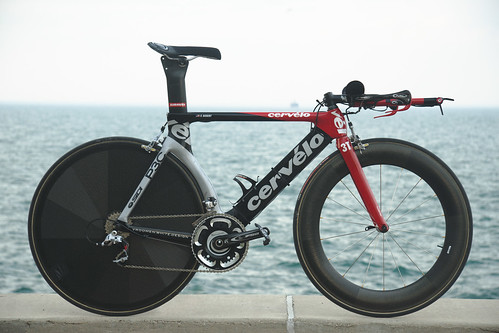The "Shorter cranks to be awesome thread" got me thinking. Please humour me! So you've changed to shorter cranks, say 165mm from 170mm for the sake of argument to allow you to drop your bars but maintain the hip angle, and hence be more aero, but so far haven't moved your saddle. You now have three choices for saddle height:
1) drop 5mm to maintain the knee angle at the top of the pedal stroke - this would seem silly as you have now negated the hip angle gain of the shorter cranks
2) raise 5mm to maintain the knee angle at the bottom of the stroke. This has the added benefit of further opening the hip angle at the top of the stroke (possibly allowing you to get even lower), but has the disadvantage of increasing your overall frontal profile and therefore increasing your aerodynamic drag (by a small amount)
3) leaving your saddle where it is, slightly changing the knee angle at both the top and bottom of your pedal stroke, but assuming the increased hip angle has allowed you to get lower without dropping power, and you haven't increased your frontal area, potentially this would be the best option?
I suppose it's a test and see situation, and depending on the exact factor that is limiting each individual will depend upon which is the best solution for them, but I wondered what the consensus was.
1) drop 5mm to maintain the knee angle at the top of the pedal stroke - this would seem silly as you have now negated the hip angle gain of the shorter cranks
2) raise 5mm to maintain the knee angle at the bottom of the stroke. This has the added benefit of further opening the hip angle at the top of the stroke (possibly allowing you to get even lower), but has the disadvantage of increasing your overall frontal profile and therefore increasing your aerodynamic drag (by a small amount)
3) leaving your saddle where it is, slightly changing the knee angle at both the top and bottom of your pedal stroke, but assuming the increased hip angle has allowed you to get lower without dropping power, and you haven't increased your frontal area, potentially this would be the best option?
I suppose it's a test and see situation, and depending on the exact factor that is limiting each individual will depend upon which is the best solution for them, but I wondered what the consensus was.

